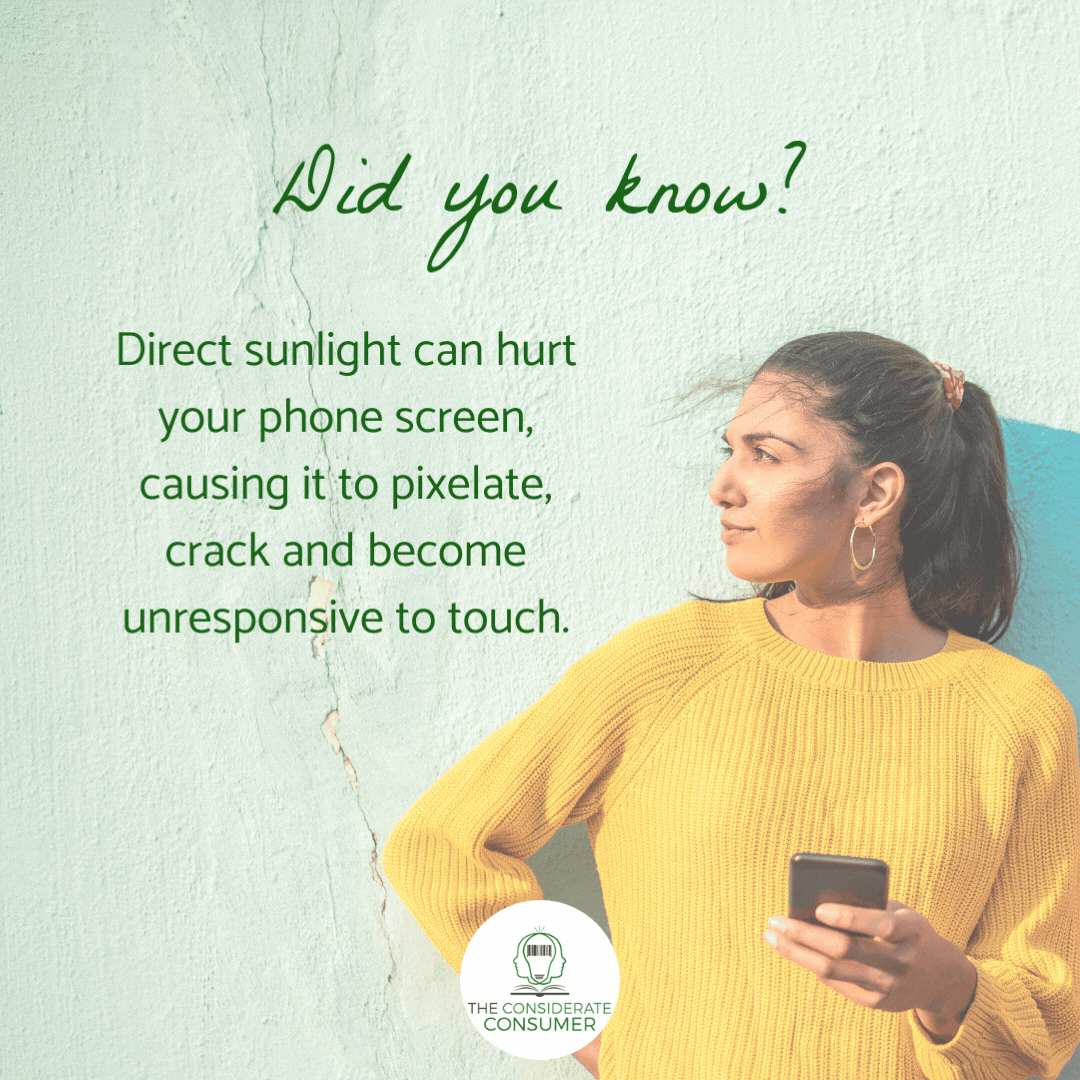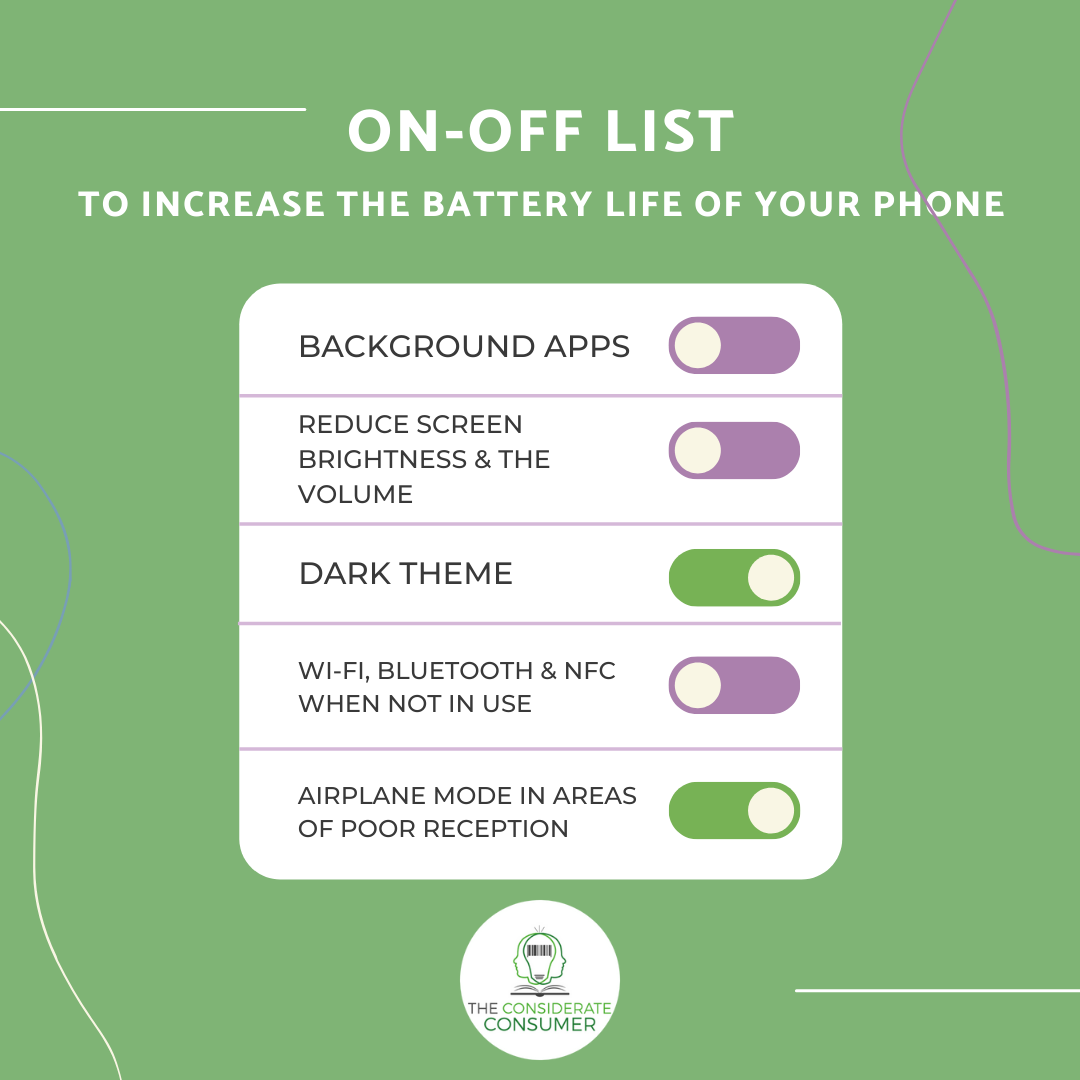Smartphones are part of our everyday lives - we use them to read the news, search for information, set alarm clocks, take pictures, or even run businesses.
However, we produce an estimated 50 million metric tons of e-waste annually, 10% of which is related to smartphones. That number is increasing rapidly.
But, we can combat this development immediately. Here is what to do.
Checklist: 6 Steps to Consume Smartphones More Considerately
Here is a rough summary of what you learn in this manual entry about a sustainable approach to your smartphone.
Take care of what you own. Get a case and a screen protector, save the battery, update your software regularly, and switch off and restart your device occasionally.
If your device can be fixed, do so! Take all the appropriate steps to maintain it and promote longevity.
Is a new device necessary? Take the time to think about your needs. If other options have been exhausted, consider making an eco-friendly purchase. Do your research on companies’ efforts to avoid being influenced by greenwashing marketing techniques.
Do you need to get rid of an old device? Don’t throw it away! Upcycle, donate or trade it in.
Opt for sustainable accessories. Wood, cork and other sustainable materials are easier on the environment and help keep your device healthy.
Take action! Use your voice to hold companies and institutions accountable to promote sustainability.
Checklist: How to Use Your Smartphone Considerately
Start with three simple steps to becoming a more considerate smartphone consumer.
Save the battery. To keep your battery going for as long as possible,
turn down the brightness of your device,
close unused apps
and do less doom scrolling on social media.
When charging, remember to unplug the smartphone once it’s back to full charge.
Keep it protected. Use a screen protector and case to protect your device from scratches and smashes. Read more to find out about sustainable Screen Protectors & Cases →.
Make sure your software is up to date. Smartphone software updates can be irritating with regular reminders and large file sizes. Still, it’s generally best to keep everything up to date, as bugs and gaps in software security could be detrimental in the long run.
REPAIRING YOUR SMARTPHONE
Try extending the life of your device by way of repairs.
Do you know that you have the “Right to Repair” your device? Check out repair.eu for more details.
Regarding phone repair, take your phone to a local specialised store.
DIY - Repair your phone yourself.
With the help of a plethora of reliable online material and just a few tools, you can pretty much solve anything if you put your mind to it.
iFixit is a terrific resource for repairing electronic devices, including tablets, game consoles, cameras, and even cars. The website provides over 70,000 repair manuals, and detailed step-by-step guides on repairing anything from screens to computer chips, hard drives and motherboards.
Check out YouTube. The platform provides many dedicated channels that specialise in DIY repair. Some good channels are Phone Repair Guru, MovilOne Phone Repair, and Go Cell Phone Repair.
CONSIDERATIONS BEFORE BUYING A NEW SMARTPHONE
One of the first questions we must ask ourselves when reducing our e-waste is whether we need a new smartphone.
In the following, we present some considerations before making a decision.
New smartphone models are released so frequently that the only major differences are a new processing chip and another camera lens. We won’t recognise the function of both of these daily.
Thus, think twice before getting the new phone.
Analyse what you use your phone for daily. We all use messaging platforms and take photos. Beyond that, what else do you need your phone for?
Does the new device provide “new” functions and options not covered by your current device? Do you know that looking in the settings might give you many options to tweak your device as needed (resolution for recording, for example)?
Do the new functions make a difference for YOU? What is possible is not yet necessary or makes sense. For example, 4 K vs. 5K quality differs little from standard HD on small device screens and social media platforms. Most platforms can’t even display or post in 4K!
Just because you can afford it doesn’t mean you need it. Is the money worth the difference you get from your purchase? Or better save the money for activities or investments!? Check out our manual entry on Sustainable Financial Investments → if you want to learn more about eco-friendly saving options.
GET A PRE-OWNED SMARTPHONES
Consider purchasing a preloved smartphone. It might require some investigation, but it is worth the time spent.
Below, we provide some tips on how to source your next preloved device.
Saving Resources With Pre-Owned Smartphones
When it comes to pre-owned smartphones, the best way we’re going to get bang for our buck is most likely going to be from refurbished and locally-sold devices. For the most part, you can negotiate prices as companies and traders will want to compete with each other. Examples range from private sellers on popular social media sites such as Facebook or high-street resellers of electronics.
Local Sourcing
One of the easiest ways to get a pre-owned device is by asking around locally. Even the ones that aren’t in the best condition, you’ll save yourself a ton of money by getting it repaired or brushed up with a specialist, or give it a go yourself!
Online Marketplaces
Alternatively, check out marketplaces, auction sites and resellers. An example is Facebook’s Marketplace feature. Popular is online marketplace eBay, not only for smartphones, but also chargers and accessories
BACKMARKET & Swappie
European tech company Swappie is specialising in refurbished smartphones. All the available smartphones are fully tested and refurbished by experts and come with warranties.
BackMarket prides itself on rigorous research into suppliers and refurbishers to get the best quality devices. They have an easy-to-use system that gives you a complete perspective on the quality of the device (plus some interesting stats on the e-waste that’s been saved). They also offer laptops, tablets and smartwatches.
Network providers
Most major network providers offer refurbished devices at a lower price than their new counterparts. As a rule of thumb, it’s best to look at "refurbished" options whenever you buy another device. Most of the time, they are classified as refurbished when there is very little difference in quality.
Repair & Second-hand shops
Consider getting help in specialised phone stores and repair shops. Often, they won’t be as expensive as most high-street retailers, and you’re still contributing to the circular economy model by purchasing a second-hand device. Try to negotiate prices.
BRAND-NEW SUSTAINABLE SMARTPHONE
Do you want a brand-new smartphone? There is a solution for this.
WHAT IS A SUSTAINABLE SMARTPHONE?
What makes a brand-new smartphone sustainable?
The following criteria characterise a sustainable brand.new smartphone:
Environmentally friendly production - for example, production with Regenerative Energy →.
Reduced CO₂ emissions.
Use environmentally friendly materials, such as renewable materials (e.g., cork, rubber), recycled materials (e.g., plastics), and certified metals (e.g., gold, tantalum, tungsten, and tin).
Long service life - software and security updates should be guaranteed for at least four years.
Replaceable components and repairability - can you open the device and get spare parts?
Amount of energy required during the charging process.
Disposal of e-waste - what does the producer do to reduce e-waste?
Sustainable smartphone PRODUCERS
Here is a list of established sustainable smartphone producers. Unfortunately, sustainable smartphones are still a niche market. Stay updated and browse the web for the latest developments before choosing.
FAIRPHONE
Fairphone stands for changing industry norms. Its products combat the huge quantities of e-waste. Plus, the phones have a modern design, use recycled materials, and are still cheaper than the latest devices from leading competitors. Fairphone prides itself on being the first and only certified gold fair trader, a huge part of the electronics pipeline that has historically had terrible conditions for the planet and its workers.
Unlike its competitors, you can take apart every aspect of the devices and replace them with new parts.
TERACUBE
Teracube produces sustainably manufactured and operated smartphones. Equipped with the latest technology you’d mostly find in other well-known brands, the company focuses on reducing e-waste by encouraging you to keep your phone going for as long as possible.
SHIFT
SHIFT is a German-made device that follows the same principles as the previous two listed above: it is modular and easily repairable. It comes apart incredibly quickly, so you can make your own repairs and upgrades. It even comes with a handy screwdriver so you can start tinkering when needed.
SMARTPHONE EQUIPMENT
Sustainability always starts with caring for what you have and keeping it going by keeping your device in good condition. More frequently than not, we scratch, chip, and demolish our phone screens more than anything, ruining the outer shell with markings that severely reduce its value.
SCREEN PROTECTOR - Get a screen protector to save money and resources and avoid needing a new mobile.
If you want to maximise your protection, look for tempered glass, which is much stronger than regular glass.
Check out Woodcessories or Pela for options.
PHONE CASE - A phone case will protect your device from scratches and scrapes that deteriorate the phone's overall look and could seriously damage the insides. Opt for environmentally friendly materials such as cork, bamboo, or wood. Check out Woodcessories, Pela, or Oceanmata to get started.
DISPOSING OF SMARTPHONES
Do you store your devices in the depths of your drawers? Whether that be because they don’t work or you just got a new device, there are a few things you can do to dispose of your old devices sustainably.
Donate your old MOBILE
Good for you: usually, you can donate your phone in any condition.
Browse the web to find charities and services in your area.
If you approach a retailer, you’ll usually get some money in cash or credit toward a new device.
If it’s a charity, the proceeds will go toward raising funds for them by sending the device to recycling companies. Fairphone.com published a great list of services and charities where you can donate, sell, or recycle your device across Europe.
trade-in YOUR DEVICE
Many large brands and third-party companies offer a trade-in offer when you hand in your old device. Sometimes, this can be a cash sum, although you’re generally bound to get a better rate with a device discount or credit to use at that particular company or establishment.
Recycle your smartphone
Give your smartphone away to any recycling program in your area. This could be in the form of local electronic bins in designated public areas or maybe at your workplace, shopping mall, or recycling facility. Browse the web for options in your area.
Learn more about Recycling Practices →.
Upcycle your smartphone
Several handy ideas exist for upcycling an old device, such as turning it into a second screen, photo frame, or even a security camera. Check out YouTube or Pinterest for the first ideas.
Samsung has an interesting upcycling programme to repurpose your smartphone into several handy smart-home featured devices, such as monitoring room thermostats and creating baby monitors with simple software updates.
LEARN MORE
Check our sources: Bibliography →

















